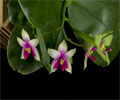|
|
|
|
|
| |
Flasks of
Phalaenopsis bellina '#737' × '#736' |
|
| |
|
|
| |
| Number: |
TN6995 |
| Name: |
Phalaenopsis bellina '#737' × '#736'
|
| Type: |
outcross (What's that?) |
|
Seed Donor: |
Armando Neves
|
|
Click to Enlarge

Pod Parent Blooming Plant |
Click to Enlarge

Pollen Parent Blooming Plant with Capsule |
|
|
|
| |
Culture Notes from Donor: Pod parent plant: Temperature range Warm-Intermediate 87-64°F. Needs to have leaves hanging down to avoid water to accumulate on them, which can lead to rot/fungus.
Pollen parent plant: Warm-Intermediate 87-64°F. Basketed in sphagnum moss with perlite.
Comments: Pod parent plant: Medium-sized plant.
Pollen parent plant: Medium-sized plant.
For additional origin/habitat information supplied courtesy of
Charles and Margaret Baker, see further below, near the bottom of this page.
|
Temperatures we attempt to use in the lab & greenhouse:
| For Species: |
|
Spring, Summer, Autumn, Winter: days average 89°F, nights 74°F; best fit is Warm 90-70°F
(Source:
Baker's Web OSC) |
| For Genus: |
|
Spring, Summer, Autumn, Winter: days average 87°F, nights 64°F; best fit is Warm-Intermediate 87-64°F
(
) |
|
About the name...
| Etymology of |
bellina |
|
From Latin "bellinus" cute, nice.
(Source:
Mayr & Schmucker 1998) |
| Etymology of |
Phalaenopsis |
|
From Greek, "phalaina" moth; "-opsis" appearance.
(Source:
Pridgeon 1992) |
| Pronunciation of |
Phalaenopsis |
|
fail-eh-NOP-sis
(Source:
Pridgeon 1992) |
| Pronunciation of |
Phalaenopsis |
|
fal-eye-NOP-sis
(Source:
Hawkes 1978) |
|
If you would like to direct someone to this web page, please copy and paste this URL into your email:
http://troymeyers.com/d?016995
| Flask Information |
| Availability: |
We have sold all of the flasks for this item. |
| You should: |
Consider getting individual plants or compots instead of a flask.
You can place a "Notify Flask Recipients" Request, and either we or a flask recipient may contact you when plants are available.
You may also place a "Notify Retries" Request, and if an identical pollination (the same parents) is done again, we'll let you know.
You may reserve a flask, but it's very unlikely you'll get one ...this could only happen if we found a flask that we didn't know we had. |
| Yield Estimate: |
320 plants (based on flask surveys done 03/29/2011 through 09/20/2011)
|
| Plantlet Sizes: |
From many flasks 25 - 60 mm plants (based on flask surveys done 08/30/2011 through 05/29/2012)
From one most recently surveyed flask 25 - 60 mm (05/29/2012)
|
|
You might also want to:
|
View the seed assay for this item.
View items of the same species.
View items of the same genus.
|
| Ordering Information |
| You are not currently logged in. |
|
You must be a registered user and be logged in to reserve a flask or place a notification request. Please log in:
|
|
|
|
|
|
| |
The origin/habitat information below is supplied courtesy of Charles and Margaret Baker
The following information is based on the name of the plant provided by the donor, and assumes that the name is correct. If the plant has been misidentified, then the following information may not be correct.
This text is copyrighted by the Bakers and may not be reproduced without permission.
ORIGIN/HABITAT: Malaya and Sarawak in Borneo. Sweet (1980) reported that
Phalaenopsis bellina f. murtoniana was originally collected near Changkat
in southern Perak state. Griesbach (1998), however, indicates that
Phalaenopsis bellina and its forms are found on Borneo while Phalaenopsis
violacea occurs in Malaya, which reflects the thinking on the distribution
of these plants that was generally accepted for many years. Recent work,
however, shows that these orchids occur in both regions, with those from
Borneo reported as originating in lowland forests while plants found on
the Malay Peninsula have been reported as occurring below 650 ft. (200 m).
More about this information and the Bakers...
|
|
|
| |
|
|
|